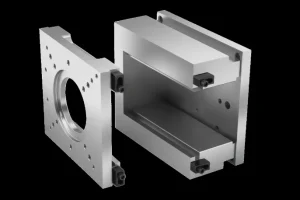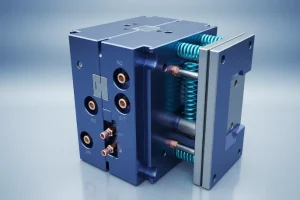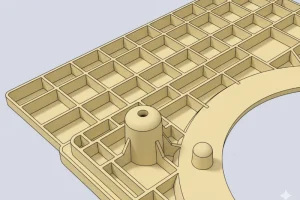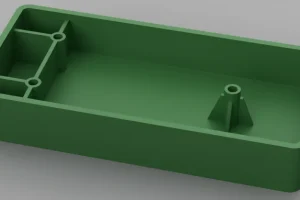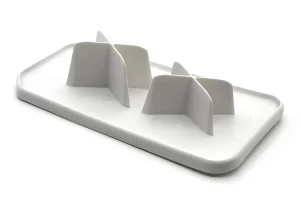Introduction
In the current era of briskly evolving manufacturing realms, the concept of rapid prototyping emerges as a pivotal technological marvel. Essentially, this approach is centered on swiftly metamorphosing design concepts into palpable, evaluable models, drastically hastening the development trajectory. Employing cutting-edge methodologies such as 3D printing, CNC machining, and additive manufacturing, rapid prototyping enables the crafting of intricate prototypes in mere fragments of the time traditionally necessitated.
Rapid prototype injection molding signifies a substantial leap forward in the manufacturing domain. Injection molding, a prevalent technique for the mass fabrication of plastic components, typically entails the creation of elaborate molds to shape molten plastic into specified configurations. The traditional modus operandi for these mold constructions is often protracted and financially burdensome, especially in the stages of developing and appraising new product designs.

Rapid prototyping introduces a revolutionary alteration in this scenario. By integrating rapid prototyping techniques into mold production, manufacturers are now equipped to generate molds with greater speed and cost efficiency. This convergence not only diminishes the time and financial outlay linked to product development but also amplifies flexibility in design and experimentation. It engenders product development process rapid manufacturing, , nurturing innovation and operational efficacy in the fabrication of injection-molded components.
The fusion of rapid prototyping and rapid injection molding is reformulating the manufacturing industry’s landscape, paving a streamlined avenue from design inception production tooling to market-ready. As we probe further into this discourse, we will unearth the diverse aspects of rapid prototyping, its methodologies, and its profound influence on the realm of injection molding.
II. Understanding Rapid Prototyping and Injection Molding
Unraveling the Enigma of Swift Prototyping tools
Swift prototyping, a conglomerate of methodologies, swiftly fashions a miniature representation of a tangible component or conglomeration utilizing tri-dimensional computer-aided design (CAD) data. Central to swift prototyping resides the employment of additive manufacturing or 3D printing technologies. In this realm, a device interprets the data from a CAD sketch and methodically deposits consecutive strata of substances to construct the model. The quintessential advantages of swift prototyping encompass the aptitude to engender intricate geometries with elevated accuracy, the brisk pace from conception to product, and the malleability to swiftly modify designs based upon tangible testing and feedback.

Elucidating Injection Molding
Contrastingly, injection molding constitutes a fabrication process for generating components through the infusion of liquefied substances into a mould. It’s prevalently utilized for bulk fabricating plastic components with consistent contours and dimensions. The process encompasses heating plastic granules until liquescence, infusing the molten plastic into a mold, chilling it to solidify into the definitive shape, followed by the expulsion of the completed part. Injection molding is lauded for its proficiency in high-volume production, the versatility in utilizing diverse materials, and the eminent quality of the end products, particularly regarding their precision and uniformity.
Convergence of Swift Prototyping and Injected Molding
The convergence of swift prototyping and injected molding heralds a significant evolution in manufacturing. Swift prototyping techniques have increasingly been harnessed to fashion prototype molds for injection molding, a traditionally tardy and costly endeavor. Through the integration of swift prototyping in mold creation, manufacturers can markedly diminish the time and expenditure linked to mold development. This confluence fosters expedited design alterations, empowering designers and engineers to refine and test their creations swiftly before plunging into the high expenses associated with traditional injection mold production. Consequently, the product evolution cycle is rendered more adaptable and efficient, catalyzing innovation and hastening the market introduction of novel products.

The amalgamation of swift prototyping with injection molding has acted as a fulcrum for transformation, particularly in sectors where rapidity, customization, and precision hold paramount importance. It offers a multifaceted platform for experimenting with assorted materials, designs, and mold configurations, culminating in superior products and more streamlined prototype injection molding manufacturing processes.
III. Advantages of Accelerated Prototyping in Injection Molding
Alacrity and Proficiency: Accelerated Prototyping’s Role in Diminishing Lead Durations
A paramount benefit of integrating rapid prototyping technology within injection molding lies in its significant abridgment of lead durations. Where traditional mold fabrication for injection molding spanned weeks or months, owing to intricate and labor-intensive methodologies, accelerated prototyping augments efficiency. Employing methods such as 3D printing, manufacturers are now poised to fabricate precise, functional prototype molds within mere days, occasionally hours. This expeditious process is vital in the contemporary, rapid market, granting the ability to swiftly transition from concept to production, thereby securing a competitive advantage. Moreover, accelerated prototyping facilitates rapid experimentation with numerous design iterations, greatly hastening the product development trajectory.
Diversity of Materials: Expanding Prototyping Options with Various Substances
Evolving technologies in rapid prototyping injection molding now embrace an extensive spectrum of materials, adding to injection molding’s versatility. Surpassing initial constraints to select plastics and resins, current rapid prototyping apparatuses accommodate an eclectic array of substances, including assorted plastics, metals, and composites. This expansion in material options is particularly salient in prototyping for injection molding. It permits manufacturers to probe various materials, determining the most fitting for their final product. Furthermore, it empowers the creation of more intricate and diverse prototypes that more closely replicate the end product’s characteristics and aesthetic, leading to more precise testing and assessment.

Economical Advantages: The Cost-Efficient Impact of Swift Tooling and Prototyping
Incorporating rapid prototyping in injection molding also yields notable economic benefits. Conventional mold crafting is not only protracted but also costly, especially when intricate or voluminous molds are involved. Rapid prototyping mitigates these expenditures in multiple facets. Firstly, it lessens reliance on costly manual labor and machining through the automation of much of the mold production process sequence. Secondly, it curtails material wastage, as additive manufacturing constructs parts layer by layer, utilizing only the requisite material quantity. Lastly, by enabling swifter design iterations and testing, rapid prototyping technique diminishes the likelihood of expensive design flaws in subsequent production phases, circumventing the costs linked with retooling or remolding. This cost-effectiveness is particularly advantageous for nascent businesses and startups with constrained budgets yet needing precise, high-quality molds for their products.
IV. Expedited Prototyping Techniques and Instruments
Compendium of Principal Techniques
Expedited prototyping is an umbrella term for a spectrum of methodologies, each distinct in its prowess and utility. Foremost among these are three-dimensional printing, CNC (Computer Numerical Control) machining, and the additive fabrication process.
Three-Dimensional Printing:
Often synonymous with rapid prototyping, this technique constructs a tri-dimensional artefact from a digital schema, methodically depositing material in successive layers. Its acclaim stems from its aptitude for forging intricate shapes and elaborate minutiae, feats often unattainable with orthodox manufacturing techniques.
CNC Machining:
This process entails the meticulous removal of material from a monolithic block, whether metallic or polymeric, to sculpt a component. Renowned for its exactitude, CNC machining yields parts with superlative mechanical attributes and surface texture. This method is particularly advantageous for prototyping functional components that necessitate material properties mirroring the ultimate product.
Additive Fabrication:
Diverging from traditional reductive methods, additive fabrication involves the incremental accretion of material, typically in layers. This category subsumes various 3D printing technologies and is lauded for its design versatility and prototyping swiftness.
Discourse on Prototyping Implements and Their Utilization
The selection of tools in rapid prototyping machines is contingent on the chosen method and the particular demands of the endeavor. For instance, diverse 3D printers cater to different materials (like stereolithography apparatus for resins, fused deposition modeling printers for thermoplastics, and so forth). Likewise, the choice of CNC apparatus, software, and cutting implements hinges on factors such as material rigidity, intricacy of the conception, and the desired prototype finish. These instruments find applications across myriad sectors, from the fabrication of complex medical apparatus to the construction of robust aerospace components.
The Centrality of Computer-Aided Design in Expedited Prototyping
At the nucleus of expedited prototyping resides Computer-Aided Design (CAD). CAD software is pivotal in fashioning detailed tri-dimensional models that act as the blueprints for prototypes. This software empowers designers to envisage and refine their conceptions with heightened precision prior to the commencement of material fabrication. CAD’s integration in rapid prototyping is vital, facilitating a fluid transition from digital design to tangible prototype, thereby assuring fidelity to design specifics. Moreover, CAD models are readily modifiable based on feedback, rendering the iterative process more rapid and efficacious.

V. Hurdles in Expedited Prototyping and Material Injection Molding
Tackling Material and Structural Integrity Dilemmas
Expedited prototyping, while brimming with advantages for injection molding, also harbors distinctive hurdles, particularly in the realm of material and structural integrity. A primary quandary lies in the divergence of properties between the prototype and its ultimate incarnation. Prototypes, frequently crafted from divergent substances or through disparate techniques compared to the final constructs, may not accurately mirror the structural attributes—like resilience, malleability, or thermal endurance—of the eventual product. This disparity can spawn inconsistencies in efficacy and operability between the prototype and the mass-fabricated articles.
To surmount these obstacles, fabricators must judiciously choose prototyping materials and methodologies that aptly replicate the characteristics of the ultimate production materials. This necessitates an extensive grasp of material science and the constraints inherent in expedited prototyping technologies. Furthermore, sophisticated simulation software can be employed to foresee variances in a prototype’s material attributes from those of the final commodity, permitting enhanced testing and scrutiny.
Equilibrating Fiscal Prudence with Excellence
An additional tribulation in amalgamating expedited prototyping with injection molding is the equilibrium between fiscal prudence and the caliber of the end product. Rapid prototyping may curtail initial expenditures and accelerate development, yet it may entail compromises in the robustness and durability of prototype molds or components. For example, molds hastily fabricated via rapid prototyping techniques may not endure as many cycles as those crafted through conventional approaches, potentially culminating in increased long-term costs owing to the necessity for frequent renewals.

Manufacturers must appraise the fiscal repercussions of rapid prototyping and strike a balance that doesn’t detract from the quality of the ultimate product. This often entails a strategic tactic to prototyping, applying rapid methods for preliminary development and analysis, followed by more conventional procedures for final production molds that demand greater durability and precision.
Navigating the Intricacies of Design and Fabrication
The integration of rapid prototyping in injection molding also introduces complexities in design and fabrication that demand astute navigation. The design process becomes more complex as it must accommodate the capabilities and limitations of rapid prototyping technologies. Designers are required to comprehend the subtleties of these technologies to optimize their creations for both rapid prototyping and final mass production. This typically requires a significant level of expertise and experience, as well as concerted collaboration between the design and manufacturing teams.
Moreover, the fabrication process must be skillfully managed to ensure a seamless transition from rapid prototypes to final production. This encompasses preparing for any alterations in the manufacturing procedure, upholding quality assurance, and overseeing supply chains for diverse materials and tools essential for both prototyping and production.

Conclusion
In the realm of manufacturing, the incorporation of rapid prototyping within plastic injection molding signifies a groundbreaking epoch. This amalgamation has not merely streamlined the mold crafting and component fabrication processes but also instilled a novel echelon of ingenuity and efficiency throughout the entire product evolution cycle. The profound diminution in lead periods, coupled with an unprecedented scope for design versatility and augmented cost efficiency, has revolutionized manufacturing capabilities.
Techniques like 3D printing and CNC machining under the umbrella of rapid prototyping have bestowed upon designers and engineers the liberty to venture into a plethora of material choices and design configurations, thus expanding the horizons of creativity and practicality. This shift has led to the democratization of manufacturing, empowering smaller ventures and nascent companies to vie with established conglomerates by accelerating product market introduction in a more economical manner.
Peering into the future, the scope and potential of blending rapid prototyping with injection molding are colossal. As these methodologies evolve and gain broader accessibility, we can anticipate even more remarkable strides in the velocity, caliber, and intricacy of manufactured items. The continual refinement of substances and techniques is poised to further narrow the chasm between prototype and final product, elevating the fidelity and dependability of prototypes.
Furthermore, the synthesis of burgeoning technologies like artificial intelligence and avant-garde simulation software into the rapid prototyping paradigm promises even more exact and streamlined manufacturing solutions. These advancements might usher in smarter production methodologies, where predictive analyses and automated design modifications become standard, further refining the manufacturing process.
To encapsulate, the convergence of rapid prototyping with injection molding marks a pivotal juncture in the manufacturing sector, signaling an era where adaptability, swiftness, and innovation are paramount. As we embrace these technological strides, the manufacturing industry stands on the brink of a profound metamorphosis, unlocking new realms of production and design that were once deemed unattainable.


